
Janine Antoni
Janine Antoni was born in the Bahamas, but lives and works in New York. She came to prominence on the American art scene in the early 1990s. Her physical and tactile works frequently combine a feminist viewpoint with art-historical references. They often occupy a borderland between performance, installation, and sculpture, as well as video and photo. Beauty pressure, body obsessions, mother-daughter relationships, and the ambivalence of traditional gender hierarchies are among her themes. The body is central to Antoni’s work, both as tool and theme, and she dares to be uncomfortably intimate. The challenge of transferring the experience of a physical sensation to sculpted objects runs through her art, and determines both her choice of materials and working methods. By employing her mouth as hammer and chisel, by drawing with her eyelids, or using her hair as a brush and different parts of her body as molds, she has transformed the daily rituals of eating, sleeping, washing, and applying make-up into sculptural processes. The renewed focus on the body in the 1990s opened up a re-actualization of Minimalism, Conceptual art, performance, video art, installation, and site-specific art. Antoni was one of the young artists who saw new possibilities in the legacy of the 1960s and 70s, inspired by the feministic performances of, among others, Ana Mendieta and Carolee Schneeman. The impact of artists such as Joseph Beuys, Dieter Roth, and Hannah Wilke (fat and chocolate as sculpting materials) and Donald Judd (the cube) were filtered in Antoni’s work through her 1980s conceptions of feminism and female identity. The emphasis that Minimalism placed on the intrinsic symbolic value of the material and the process was also important to Antoni. She had studied sculpture, but spurned traditional materials for more unusual substances. To capture the nuances of intimacy she has chosen to use chocolate and solid fat, soap, hair dye, animal skin, and textiles. In Saddle (2000) the empty shell of a cowhide hugs a cast of her body made when down on all fours. The hide both veils and reveals, and the pose suggests submission and possibly humiliation. Works such as Gnaw (1992), Lick and Lather (1993), and Slumber (1994) were both sculptures and processes. Here, Antoni explored consumer culture, the cult of beauty, and myths of art history. For the installation Gnaw she literally devoured society’s view on feminism and spat it out again by chewing on two minimalistic cubes, 270 kilo blocks of chocolate and solid fat, and spitting out the chewed gobbets. These were then melted and formed into heart-shaped confectionary boxes and tempting lipsticks, which were exhibited with the remainders of the cubes in the gallery. Gnaw was recognized as a feminist reply to Minimalism’s masculine forms of expression, while also attacking society’s attitude to the female body and the pressures it places on women. Antoni narrates her stories through sculptural surfaces, but leaves room in the story for observers to fill in the gaps. A paradox in her works is that much of their physicality actually derives from the absence of a body. We observe instead impressions left by a body or the leftovers of bodily processes. These activate the observer’s body memory so that we begin intuitively to visualize the various actions that have taken place. In this way, Antoni emphasizes the actual physical act of creating art, and invites the observer to collaborate in the process.